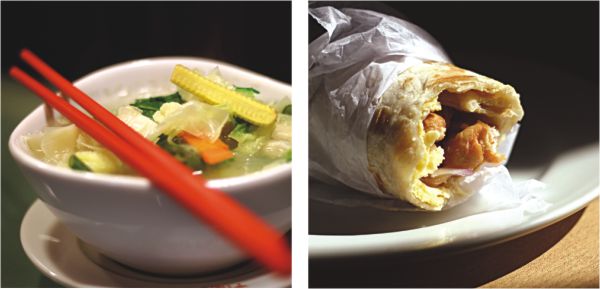Extra Credit
Crispy, Fried and Dried
Sabhanaz Rashid Diya
Photos: Kazi Tahsin Agaz Apurbo
Meeting Jamie Oliver in September last year was quite a bemusing experience. A world renowned chef and food activist, Oliver's most recent venture challenged schools across the West to serve good quality and healthy food in their respective cafeterias. The problem was obesity and related heart diseases; children were falling sick because of excessive junk food and not getting a fitting diet for healthy growth. The experience, as I mentioned earlier, was intriguing. I represented a country whose philosophy of poverty circled around low nutrition and I did little justice to the popular image of a skinny child suffering from malnutrition begging for money to buy food. The contrast was striking, and as our conversation went forward, we realised food wasted is nothing more than food created.

However, as I write this piece sitting inside a comfortable room yet sweating uncontrollably because of loadshedding while the world just beyond my balcony is still trying to figure out a formula to put food and poverty in an agreeable equation, I realise Jamie Oliver may as well have made a point. Surprisingly, he made a point that I could relate to every time I walked inside a university cafeteria. Good quality, healthy food at affordable prices was clearly an international concern, and in spite of popular images, Bangladesh had just as much to worry about.
On a typical day at any private university in Dhaka, it is difficult to find a fulfilling meal below a hundred bucks. The items on the plate vary between a combination of fried rice with unnecessarily crispy fried chicken or a variation between khichuri or tehari. Couple that with a glass of a fizzy soft drink, freshly refrigerated and “bang!” it seems the cafeteria owners have hit jackpot. Students, caught between creativity and cubicle culture have less time to worry or complain about food, and devour whatever is in front of them. Imagine a menu as such for five straight days every week, which statistically estimates to an average of 333 calories for a cup of fried rice plus 102 calories for a fried chicken drumstick (with skin) plus 139 calories for a can of Coke (sources: coca-cola.com, fatsecret.com, livestrong.com). Easily, the weekly intake of calories from a single, typical university cafeteria meal per day sums up to roughly 2870 calories. Add a white rice dinner and parata wala breakfast, and the number exceeds 3000 calories. The standard daily intake of calories for healthy living should not exceed 2000 calories (source: livestrong.com), so essentially, the over consumption of carbohydrate and fat is leaving an alarming impact on our health.
Calories aside, the cost-benefit ratio of cafeteria food is just as disappointing. A standard meal costs over a hundred bucks, so five days multiplied by one meal per day equals to an expense of 500 bucks per week only on food. For an average student coming from a middle class family background, such expense is irrational, almost impossible to maintain. Yet, students are often left without a choice given each university usually hosts a single central cafeteria contracted out to a food agent and meeting costs at all levels become complex.
Walking inside a public university cafeteria may be slightly more reassuring. For starters, there are more options and prices are lower, yet preparation and serving often leave the feeble hearted with an basic hygiene standards and lack central administrative supervision or quality control.
So, what can be done? My entrepreneurial nerves are constantly playing Snake inside my head, and like any problem that when decentralised or democratised to an extent can have remarkable and effective solutions food perhaps has the same hope. If students were allowed to create their own food corners within university, greater competition would inspire quality food at lower prices. At Brandeis University in the US, for example, students have created their own food shops, some serving specific kinds of food while others serving a range of items and have given their contemporaries much to think and munch about. In addition, university administration can consider putting bars on food standards and prices, hence ensuring healthy, calorie-friendly menus within reach. Simultaneously, food evaluation charts can keep contracted food agents under constant monitoring, thereby creating physical estimates on what is working and not working for students. Food festivals are a great way to encourage a variety of food shops to enter your premises and allow management authorities to get more insight into popular cultures and student demands.
Jamie Oliver, although debatably, has already started a food revolution in the West. The East, perhaps simply needs a few switches to work, and more flexibility on part of the students. Quality food, particularly for those like me who think with their tummies can truly create happier students, and happier students are clearly better students. This food chain may seem laughable at this point, but ten years down the line, increasing heart diseases and premature strokes will surely prove otherwise. More juice, anyone?
(Sabhanaz Rashid Diya is a major in Media and Communication at Independent University Bangladesh and founder of the nonprofit youth organization, the One Degree Initiative Foundation.)

|
|
|
